Multiple rocket launcher
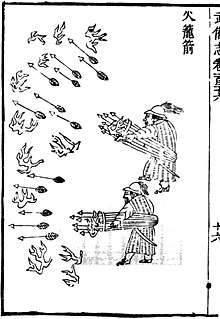
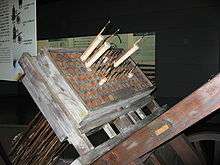
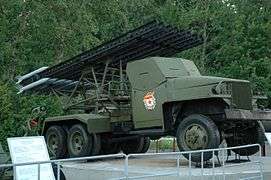
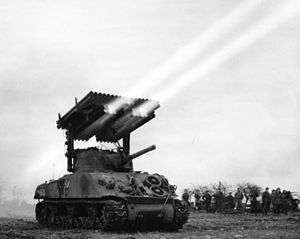
.jpg)
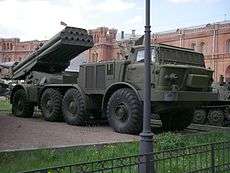

A multiple rocket launcher (MRL) or multiple launch rocket system (MLRS) is a type of rocket artillery system. Rockets have different capabilities than artillery, like longer range, and different payloads, typically considerably larger warheads than a similarly sized artillery platform, or multiple warheads. Unguided rocket artillery is notoriously inaccurate and slow to reload, compared to artillery. To overcome this, rockets are combined in systems that can launch multiple rockets simultaneously. Modern rockets can use GPS or inertial guidance, to combine the advantages of rockets with high accuracy.
History
The first multiple rocket launchers, huo che, were made during the medieval Chinese Song dynasty. It was designed to launch multiple rocket arrows from a gunpowder box. These also appeared later, in an expanded version, in the Joseon Dynasty of Korea, where they were used with great effectiveness against the Japanese invasions of 1592–98, most notably the Battle of Haengju.[1] In parallel with Song Chinese development of guns and cannons, the Song military invested great efforts in producing military rockets, including multiple rocket launchers mounted on wheelbarrows.[2] Multiple rocket launchers evolved from Chinese fire lances when the Song military favored multiple rocket launchers that fired simultaneously up to 100 small fire-arrow rockets after the Mongol siege of Kaifeng. The typical powder section of such an arrow-rocket was 1/3 to 1/2 ft (10 to 15 cm) long. Bamboo arrow shafts varied from 1.5 ft (45 cm) to 2.5 ft (75 cm) long and the striking distance reached 300 to 400 paces. The Chinese also enhanced rocket tips with poison and made sure that the launchers were also mobile. Song Chinese rocket designers designed multiple rocket launchers that could be carried and operated by a single soldier.[3]
European armies preferred relatively large single-launch rockets prior to World War II; Napoleonic armies of both sides and prior followed British adoption of Mysore Army explosive steel-cased bombardment rockets with minimal launchers. European navies developed naval multiple launcher mounts with steadily improving explosive rockets for light and coastal vessels. These weapons were largely replaced by conventional light artillery during the late nineteenth century.
World War II
The first self-propelled multiple rocket launchers — and arguably the most famous — were the Soviet BM-13 Katyusha, first used during World War II and exported to Soviet allies afterwards. They were simple systems in which a rack of launch rails was mounted on the back of a truck. This set the template for modern multiple rocket launchers. The Americans mounted tubular launchers atop M4 Sherman tanks to create the T34 Calliope rocket launching tank, only used in small numbers, as their closest equivalent to the Katyusha. The Germans began using a towed six-tube multiple rocket launcher during World War II, the Nebelwerfer, also called the "Screaming Mimi" by the Allies.
Types
There is two main types of multiple rocket launchers:
- With tubes or pipes usually in modern times made of steel - non removable from launcher, with possibilities to be reloaded in terrain - battlefield - with rockets manual or semi automatically loaded. This was most usual type until 21 century. It is more convenient for usage in terrain because it does not request special tools to reload modules and test them before using them on launchers as in other type.
- With containers, pods or modules that can be removed from launcher and quickly replaced with same or different types of rockets and calibers. They are usually reloaded at factory or within specialized equipped army shops. This is more modern types of weapons as they are not necessarily related to just one type of rocket and give more possibilities to commanders on field to solve different tactical situations with different types of rockets or to quickly reload. They are more easy to be modernized with new types of rockets.
Current usage
Simple MRL types still have a reputation of having a devastating morale effect on ill-disciplined or already shaken troops. The material effect depends on circumstances, as well-covered field fortification provide much protection.
MRL are still rarely able to properly shoot at rear slope positions in mountain warfare because the MRL crew cannot determine the trajectory as well as a howitzer's crew can do by adding or removing propellant increments. Simple MRL rocket types have a rather long minimum firing range for the same reason. An approach to lessen this limit is the addition of drag rings to the rocket nose. The increased drag slows the rocket down relative to a clean configuration and creates a less flat trajectory. Pre-packaged MRL munitions such as with MLRS do not offer this option, but some MRL types with individually-loaded rockets do.[4]
Improvised multiple rocket launchers based on helicopter- or aircraft-mounted rocket pods (typically of 57–80 mm caliber) on light trucks and pickups (so-called "technicals") are especially often sighted in civil wars, when rebels make use of captured launchers and munitions.[5]
The Convention on Cluster Munitions has led to the destruction and cessation of production of most cluster munitions for MRLs. Large submunitions, smoke agents, and unitary high explosive warheads are still permitted under the Convention.
Included among the still-legal submunitions are relatively large Explosively Formed Projectile (EFP) warheads with sensors (millimetre wave radar, infrared) which search the ground for tanks to attack in a spiral pattern during their descent (retarded by parachutes). Western examples are SMArt 155, 155 Bonus,[6] and SADARM.
Modern MRL systems can use modern land navigation (especially satellite navigation such as GPS) for quick and accurate positioning. The accurate determination of the battery position was previously enough effort to make a dispersed operation of the battery impractical. MRL systems with GPS can have their MRLs dispersed and shoot from dispersed positions at a single target, just as previously multiple batteries were often united on one target area.
Radars are in use to track weather balloons to determine winds or to track special rockets which self-destruct in the air. The tracking allows determination of the influence of winds and propellant temperatures on the rocket's flight path. These observations can then be factored into the firing solution for the rocket salvo for effect.
Such tracking radars can also be used to predict the range error of individual rockets. Trajectory correcting munitions may then benefit from this, as a directional radio may send a coded message to the rocket to deploy air brakes just at the right time to correct most of the range error. This requires that the rockets were originally aimed too far, as the range can only be shortened by the air brakes, not extended. A more sophisticated system makes use of radar data and one-way radio datalink to initiate a two dimensional (range and azimuth) correction of the rocket's flight path with steering by fins or nose thrusters. The latter is more common with systems which can be used to upgrade old rockets and the Israeli Accular[7] is an example.
.jpg)
Fin-stabilised rockets also allow for easy course corrections using rudders or minute charges. Guided munitions have been introduced to exploit this. Guidance principles such as GPS satellite navigation, inertial navigation system and semi-active laser seekers are used for this. This improves dispersion from a CEP of hundreds of metres at dozens of kilometers range to just a few meters, and (except for INS, as INS navigation creates a small dispersion that's about proportional to range) largely independent of the range of the shot. This in turn made great increases of rocket (or missile) ranges useful; previously dispersion had made rockets too inefficient and often too dangerous to friendly troops at long ranges. Long range MRL missiles often fly a higher quasiballistic trajectory than shorter ranged rockets and pose thus a deconfliction challenge, as they might collide with friendly aircraft in the air.
The border between a MRL missile and a large anti-tank guided missile such as Nimrod has become fuzzy due to guided MRL missiles such as M31 GUMLRS.[8]
See also
- List of rocket artillery
- List of U.S. Army Rocket Launchers By Model Number
- Nebelwerfer family of multiple rocket launchers, World War II Wehrmacht
- Rouketopolemos
- Transporter erector launcher
References
- ↑ |Title: What Life was Like in the Land of the Dragon |Publisher: Time-Life; First Edition (October 1998) | ISBN 978-0783554587
- ↑ James, Peter J.; Thorpe, Nick; Thorpe, I. J. (1995). Ancient Inventions. Ballantine Books. p. 238. ISBN 978-0345401021.
- ↑ Gruntman, Mike (2005). Blazing the Trail: The Early History of Spacecraft and Rocketry. American Institute of Aeronautics. pp. 5–6. ISBN 978-1563477058.
- ↑ Jane's Armour and Artillery 2011-2012 data sheets
- ↑ "Archived copy" (PDF). Archived (PDF) from the original on 2014-09-24. Retrieved 2014-08-17.
- ↑ "BONUS Mk II". www.deagel.com. Archived from the original on 2014-08-19.
- ↑ "Archived copy" (PDF). Archived (PDF) from the original on 2015-07-15. Retrieved 2014-08-18.
- ↑ "Archived copy". Archived from the original on 2014-08-11. Retrieved 2014-08-18.